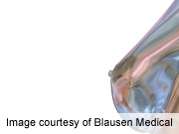Agreement between community-based radiologists and an expert radiology panel for interpreting mammograms is high for cancer cases and obvious findings, but is low for subtle and asymmetric lesions, calcifications, asymmetric densities, and architectural distortions, according to a study published in the November issue of the Journal of the American College of Radiology.
(HealthDay)—Agreement between community-based radiologists and an expert radiology panel for interpreting mammograms is high for cancer cases and obvious findings, but is low for subtle and asymmetric lesions, calcifications, asymmetric densities, and architectural distortions, according to a study published in the November issue of the Journal of the American College of Radiology.
Tracy Onega, Ph.D., of the Dartmouth Medical School in Hanover, N.H., and colleagues conducted a study involving 119 community-based radiologists from six mammographic registries who were recruited to assess one of four randomly assigned test sets of 109 screening mammographies for recall or no recall and to provide the most significant finding type and location. The level of agreement with an expert radiology panel was assessed according to cancer status and finding type.
The researchers found that, for masses and examinations with obvious findings in cancer and non-cancer cases, the recall agreement was 100 percent. Recall agreement was lower among cancer cases for more subtle findings (50 percent) or asymmetric findings (60 percent). Recall agreement was 33 percent for subtle non-cancer findings and benign calcifications. Recall agreement was low for architectural distortions (43 percent) and asymmetric densities (40 percent). Asymmetric densities accounted for most (51 percent) unnecessary recalls.
"Our analysis of mammographic interpretation agreement between radiologists and an expert panel suggests that mammographic training should focus on identification and correct interpretation of asymmetric densities and architectural distortions," the authors write.
More information:
Abstract
Full Text
Journal information: Journal of the American College of Radiology
Copyright © 2012 HealthDay. All rights reserved.


















